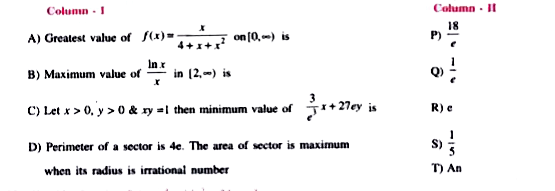Let f.g.h be real valued functions defined on the interval [0,1] by f(x)=ex2+e−x2,g(x)=x.ex2+e−x2andh(x)=x2,ex2+e−x2 If a,b,c denote respectively the absolute max. values of f.g.h on [0,1] then Solution in Telugu
a=bandc≠b
a=canda≠b
a≠bandc≠b
a=b=c
The correct Answer is:D
Step by step video, text & image solution for Let f.g.h be real valued functions defined on the interval [0,1] by f( x) = e^(x^(2)) +e^(-x^(2)) , g (x)= x.e^(x^(2)) +e^(-x^(2)) and h (x) = x^(2) ,e^(x^(2)) +e^(-x^(2)) If a,b,c denote respectively the absolute max. values of f.g.h on [0,1] then by Maths experts to help you in doubts & scoring excellent marks in Class 11 exams.
Updated on:21/07/2023Topper's Solved these Questions
- MAXIMA AND MINIMA BOOK - AAKASH SERIESCHAPTER - MAXIMA AND MINIMA EXERCISE - LECTURE SHEET (EXERCISE -II) (MORE THAN ONE CORRECT ANSWER TYPE QUESTIONS)
6 Videos
- MAXIMA AND MINIMA BOOK - AAKASH SERIESCHAPTER - MAXIMA AND MINIMA EXERCISE - LECTURE SHEET (EXERCISE -II) (MATRIX MATCHING TYPE QUESTIONS)
3 Videos
- MAXIMA AND MINIMA BOOK - AAKASH SERIESCHAPTER - MAXIMA AND MINIMA EXERCISE - LECTURE SHEET (EXERCISE - I ) (INTEGER TYPE QUESTIONS)
3 Videos
- MAXIMA & MINIMABOOK - AAKASH SERIESCHAPTER - MAXIMA & MINIMAEXERCISE - EXERCISE-III
35 Videos
- MEAN VALUE THEOREMSBOOK - AAKASH SERIESCHAPTER - MEAN VALUE THEOREMSEXERCISE - PRACTICE SHEET (EXERCISE-I (LEVEL-II (MORE THAN ONE CORRECT ANSWER TYPE QUESTIONS ) )
2 Videos
Similar Questions
Let the function f (x) be defined as follows : f(x)=⎧⎪ ⎪⎨⎪ ⎪⎩x3+x2−10x,−1≤x<0cosx,0≤x<π2.1+sinx,π2≤x≤πThen f(x) has
View SolutionMatch the max l min value of function in Column I with corresponding values in Column -II

View SolutionLet {x3+x2+3x+sinx∣(3+sin1x)x≠00x=0 Then the number of points where f(x) attrains its minimum value is ___________
View SolutionThe maximum slope of the curve y=−x3+3x2+9x−27 is
View SolutionGiven f(x) = 4- ((1)/(2) - x)^(2//3) , g(x) = {:{((tan[x])/(x),","x cancel(=)0),(1,","x=0):}" "h(x)={x}, k (x) = 5^(log_(2)(x+3))
Then in [0,1], Lagrange's mean value theorem is not applicable to (where [.] and {.} represents the greatest integer functions and fractions part functions, respectively )
View SolutionLet f,g and h be real-valued functions defined on the interval [0,1] by f(x)=e^(x^(2))+e^(-x^(2))g(x)=xe^(x^(2))+e^(-x^(2)) and h(x)=x^(2)e^(x^(2))+e^(-x^(2))* if a,b and c denote respectively,the absolute maximum of f,g and h on [0,1] then
View SolutionLet f be a real valued function defined by f(x)=ex−e−|x|ex+e|x| , then the range of f(x) is: (a)R (b) [0,1] (c) [0,1) (d) [0,12)
View SolutionLet f(x) be defined in (0,1), then the domain of definition of f(e^(x))+f(ln|x|) is (A) ((1)/(e),1) (B) (-e,-1)(C)(1,e)(D)(e^(2),e^(2)+2)
View SolutionIf f:R-> R such that f(x)=ln(x+sqrt(x^2+1)). Another function g(x) is defined such gof(x)=x, for all x in R. Then g(2) is (A) (e^2+e^-2)/2 (B) (e^2-e^-2)/2 (C) e^2 (D) e^-2
View SolutionLet f, g and h be real-valued functions defined on the interval [0, 1] by f(x)=ex^2+e−x^2, g(x)=xex^2+e−x^2 and h(x)=x2ex^2+e−x^2 . If a,b, and c denote respectively, the absolute maximum of f, g and h on [0, 1], then a=b and c≠b (b) a=c and a≠b a≠b and c≠b (d) a=b=c
View Solutionमाना कि f g एवं h. वास्तविक मान वाले फलन हैं जो अन्तराल [0, 1] पर निम्न प्रकार से परिभाषित हैंf-
f(x)=ex2+e−x2,g(x)=xex2+e−x2 एवं h(x)=x2ex2+e−x2
यदि a, b एवं c क्रमशः f, g एवं के [0, 1] पर परम उच्चिष्ठ हैं, तब
View Solutionफलन f(x)=ex2−e−x2ex2+e−x2 द्वारा परिभाषित फलन f : R→ Rहै----
View SolutionLet f, g and h be real-valued functions defined on the interval [0, 1] by: f(x)=e^(x^(2)) +e^(-x^(2)), g(x)=xe^(x^(2))+e^(-x^(2)) and h(x)=x^(2)e^(x^(2))+e^(-x^(2)) . If a, b and c denote respectively the absolute maximum of f, g and h on [0, 1], then :
View Solutionमाना कि f,g एवं h वास्तविक मान वाले फलन है जो अंतराल [0,1] पर निम्न प्रकार से परिभाषित है f(x)=ex2+e−x2,g(x)=xex2+e−x2 एवं h(x)=x2ex2+e−x2. यदि a,b एवं c क्रमश f,g एवं h के [0,1] पर अधिकतम मान है , तब
View SolutionLet f, g, h be real valued functions defined on the interval [0, 1] by f(x)=ex2+e−x2, g(x)=xex2+e−x2 and h(x)=x2ex2+e−x2. If a, b, c respectively denote the absolute maximum of f, g and h on [0, 1] then show that a =b=c.
View Solutionमाना कि f g एवं h. वास्तविक मान वाले फलन हैं जो अन्तराल [0, 1] पर निम्न प्रकार से परिभाषित हैंf-
f(x)=ex2+e−x2,g(x)=xex2+e−x2 एवं h(x)=x2ex2+e−x2
यदि a, b एवं c क्रमशः f, g एवं के [0, 1] पर परम उच्चिष्ठ हैं, तब
View Solution
